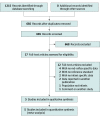Diagnostic Test Accuracy of the Red Reflex Test for Ocular Pathology in Infants: A Meta-analysis
- PMID: 33180103
- PMCID: PMC7662495
- DOI: 10.1001/jamaophthalmol.2020.4854
Diagnostic Test Accuracy of the Red Reflex Test for Ocular Pathology in Infants: A Meta-analysis
Abstract
Importance: Red reflex testing is a simple and inexpensive method implemented in many countries as an important part of infant screening for ocular pathologies.
Objectives: To review the literature on the diagnostic accuracy of the red reflex test in infant screening for ocular pathologies and to perform meta-analyses to provide summary estimates.
Data sources: The following literature databases were searched for English-language, peer-reviewed literature, published until April 19, 2020: Cochrane Central, PubMed/MEDLINE, Embase, Web of Science Core Collection, BIOSIS Previews, Current Contents Connect, Data Citation Index, Derwent Innovations Index, KCI-Korean Journal Database, Russian Science Citation Index, SciELO Citation Index, CINAHL (Cumulative Index to Nursing and Allied Health Literature), and ClinicalTrials.gov.
Study selection: Eligibility criteria were defined according to population (studies of consecutively screened infants), exposure (red reflex or Brückner test as the index test), comparator (any ophthalmological examination), and study type (any study with diagnostic test accuracy data).
Data extraction and synthesis: The Preferred Reporting Items for Systematic Reviews and Meta-Analysis of Diagnostic Test Accuracy Studies (PRISMA-DTA) guidelines were followed. Data were extracted independently by 2 authors. For summary estimates of diagnostic test accuracy, the hierarchical summary receiver operating characteristics curve was used. Prevalence of ocular pathologies was introduced for a prevalence meta-analysis, which was then used in calculations of diagnostic accuracy of the red reflex test when applied in infant screening.
Main outcomes and measures: True-positive, false-positive, true-negative, and false-negative findings; sensitivity; specificity; and positive and negative predictive values.
Results: In this meta-analysis, 8713 unique infants from 5 unique studies were eligible for qualitative and quantitative review. All studies used the red reflex test without pupillary dilation and were compared with a reference test performed with pupillary dilation. For any ocular pathology, an estimated sensitivity of 7.5% (95% CI, 7.4%-7.5%) and specificity of 97.5% (95% CI, 97.5%-97.5%) was found. Focusing on ocular pathologies that required a medical or surgical intervention, sensitivity improved to 17.5% (95% CI, 0.8%-84.8%) and specificity remained high at 97.6% (95% CI, 87.7%-99.6%).
Conclusions and relevance: These findings suggest that an abnormal red reflex finding most likely reflects an underlying ocular pathology. However, a normal red reflex finding during screening does not exclude ocular disease.
Conflict of interest statement
Figures


Comment in
-
The Enduring Value of Newborn Red Reflex Testing as a Screening Tool.JAMA Ophthalmol. 2021 Jan 1;139(1):40-41. doi: 10.1001/jamaophthalmol.2020.4853. JAMA Ophthalmol. 2021. PMID: 33180105 No abstract available.
-
The Red Reflex Test - Shadow conceals, light reveals.Indian J Ophthalmol. 2021 Aug;69(8):1979-1981. doi: 10.4103/ijo.IJO_1917_21. Indian J Ophthalmol. 2021. PMID: 34304157 Free PMC article. No abstract available.
Similar articles
-
Clinical utility of serologic testing for celiac disease in ontario: an evidence-based analysis.Ont Health Technol Assess Ser. 2010;10(21):1-111. Epub 2010 Dec 1. Ont Health Technol Assess Ser. 2010. PMID: 23074399 Free PMC article.
-
Beyond the black stump: rapid reviews of health research issues affecting regional, rural and remote Australia.Med J Aust. 2020 Dec;213 Suppl 11:S3-S32.e1. doi: 10.5694/mja2.50881. Med J Aust. 2020. PMID: 33314144
-
Assessment of C-Reactive Protein Diagnostic Test Accuracy for Late-Onset Infection in Newborn Infants: A Systematic Review and Meta-analysis.JAMA Pediatr. 2020 Mar 1;174(3):260-268. doi: 10.1001/jamapediatrics.2019.5669. JAMA Pediatr. 2020. PMID: 32011640 Free PMC article.
-
Can the Red Reflex Test Detect Unequal Refractive Error?J Pediatr. 2019 Nov;214:175-177. doi: 10.1016/j.jpeds.2019.06.051. Epub 2019 Aug 1. J Pediatr. 2019. PMID: 31378518
-
The Use of Postnatal Weight Gain Algorithms to Predict Severe or Type 1 Retinopathy of Prematurity: A Systematic Review and Meta-analysis.JAMA Netw Open. 2021 Nov 1;4(11):e2135879. doi: 10.1001/jamanetworkopen.2021.35879. JAMA Netw Open. 2021. PMID: 34812847 Free PMC article.
Cited by
-
EyeScreen: Development and Potential of a Novel Machine Learning Application to Detect Leukocoria.Ophthalmol Sci. 2022 Apr 15;2(3):100158. doi: 10.1016/j.xops.2022.100158. eCollection 2022 Sep. Ophthalmol Sci. 2022. PMID: 36245758 Free PMC article.
-
The approach to the screening for visual impairment of children and adolescents by family medicine physicians in the Eastern Region of Saudi Arabia.J Family Community Med. 2025 Jul-Sep;32(3):198-206. doi: 10.4103/jfcm.jfcm_275_24. Epub 2025 Jul 14. J Family Community Med. 2025. PMID: 40785956 Free PMC article.
-
Newborn screening for hearing and sight, Cameroon.Bull World Health Organ. 2025 Jun 1;103(6):375-382. doi: 10.2471/BLT.24.292431. Epub 2025 May 3. Bull World Health Organ. 2025. PMID: 40511396 Free PMC article.
-
Retinoblastoma: Review and new insights.Front Oncol. 2022 Nov 2;12:963780. doi: 10.3389/fonc.2022.963780. eCollection 2022. Front Oncol. 2022. PMID: 36408154 Free PMC article. Review.
-
Portable wide-field digital imaging for screening of neonatal visual impairment causes in Rio de Janeiro, Brazil: a budget impact analysis.BMJ Open. 2022 Jun 10;12(6):e056498. doi: 10.1136/bmjopen-2021-056498. BMJ Open. 2022. PMID: 35688584 Free PMC article.
References
-
- American Academy of Pediatrics; Section on Ophthalmology; American Association for Pediatric Ophthalmology and Strabismus; American Academy of Ophthalmology; American Association of Certified Orthoptists . Red reflex examination in neonates, infants, and children. Pediatrics. 2008;122(6):1401-1404. doi:10.1542/peds.2008-2624 - DOI - PubMed
Publication types
MeSH terms
LinkOut - more resources
Full Text Sources
Other Literature Sources
Medical
Miscellaneous

